While some comics creators have been interested in telling stories about the traditional Arthurian figures, others have drawn inspiration from the legend in creating their own characters. In particular, the figure of the idealistic knight-errant who sets forth into the world to protect the innocent and thwart the wicked has proven an effective model for a number of comics heroes. Generally, these characters have appeared in their own comic strip or comic book series. However, while a comic strip series like "Prince Valiant" is largely self-contained, comic book characters often appear in a variety of series from the same publisher. Most comic book superheroes participate in a shared fictional universe with their publishers' other heroes and make frequent guest appearances or "crossovers". Revamping of characters' premises and fictional background, or continuity, is also common in modern comics.
All of the characters discussed below have their beginnings in an Arthurian-derived premise which then becomes part of the character's background, receiving more or less emphasis depending on the inclinations of the creators handling the character at any given time. Rather than attempting a complete checklist of each character's every appearance, I am listing what I consider to be key appearances -- "key" being defined as either critical to the character's overall development, or particularly notable for Arthurian content. (Original series runs are "key" by definition.)
Created by Stan Lee and Joe Maneely in Black Knight #1 (1955).
Key appearances (all published by Marvel Comics, USA, except as noted):
The original Black Knight was a knight of King Arthur's court,
Sir
Percy of Scandia. Following the example of swashbuckers like the Scarlet Pimpernel and Zorro (and countless comic book
superheroes), the Black Knight had a double identity. As Sir Percy,
he appeared to be a timid fop, but as the mysterious Black Knight
(whose helmet completely covered his face), he was the greatest of
Camelot's champions. As told in Black Knight #1,
Merlin
enlisted Sir Percy to act in secret opposition to the plotting of
Arthur's evil nephew Mordred. After the Black Knight successfully
defended Arthur against an attack engineered by Mordred, the King
accepted him into his service. The Black Knight foiled the schemes of
Mordred and his ally Morgan Le Fey for another four issues before the
series folded. (The entire series has been reprinted in the hardcover volume Marvel Masterworks: Atlas Era Black Knight/Yellow Claw, Vol. 1.)
like the Scarlet Pimpernel and Zorro (and countless comic book
superheroes), the Black Knight had a double identity. As Sir Percy,
he appeared to be a timid fop, but as the mysterious Black Knight
(whose helmet completely covered his face), he was the greatest of
Camelot's champions. As told in Black Knight #1,
Merlin
enlisted Sir Percy to act in secret opposition to the plotting of
Arthur's evil nephew Mordred. After the Black Knight successfully
defended Arthur against an attack engineered by Mordred, the King
accepted him into his service. The Black Knight foiled the schemes of
Mordred and his ally Morgan Le Fey for another four issues before the
series folded. (The entire series has been reprinted in the hardcover volume Marvel Masterworks: Atlas Era Black Knight/Yellow Claw, Vol. 1.)
Several years later, the Black Knight was resurrected, after a fashion, when Tales To Astonish #52 (Feb, 1964) introduced a super-villain of the same name. This Black Knight was Professor Nathan Garrett, a scientist who had created a winged horse and advanced weaponry such as a "power-lance". After being defeated by Giant-Man and the Wasp in his first appearance, the Black Knight returned as a member of the Masters of Evil in Avengers #6 (reprinted in color in Marvel Masterworks, Vol. 4: The Avengers #1-10 and in black and white in Essential Avengers. Vol. 1). He made a couple of succeeding appearances as a foe of the Avengers and also battled the armored Avenger, Iron Man, in Tales of Suspense.
In the 48th issue of Avengers (Dec., 1967,
written by Roy
Thomas and drawn by John Buscema; reprinted in black and white in
Essential Avengers, Vol. 3) readers learned that
Garrett had
been mortally wounded in his last battle against Iron Man and had
bequeathed the Black Knight's identity to his nephew, scientist Dane
Whitman, in exchange for a vow that Whitman serve the cause of good.
The Black Knight soon encountered the Avengers and shared several
adventures with them before becoming a member of the superhero band
in issue 71. Meanwhile, he was cover-featured in a solo adventure in
the 17th issue of the showcase title Marvel Super-Heroes (Nov., 1968).
Here
author Thomas revealed that both Whitman and Garrett were descendants
of Sir Percy of Scandia. Sir Percy had perished in the final battle
of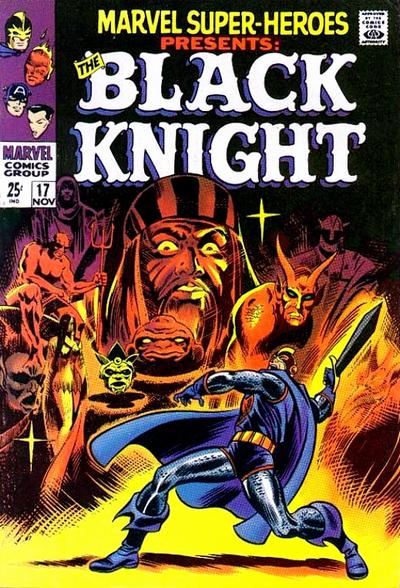 the knights of Camelot, slain by Mordred after the traitor had
already killed Arthur. As Percy lay dying, Merlin cast a spell which
enabled the Black Knight's spirit to return whenever Mordred's own
immortal spirit reemerged to work evil. Percy's wraith had called to
Nathan Garrett, who hadn't answered in a worthy fashion; Dane
Whitman, however, was destined to be Sir Percy's true heir. Whitman
was given the Ebony Blade, an enchanted sword which had been carved
from a meteor by Merlin, and was soon using it in battle against a
mortal pawn of Mordred, whose spirit had indeed survived the
centuries in the service of the "Nether Gods".
the knights of Camelot, slain by Mordred after the traitor had
already killed Arthur. As Percy lay dying, Merlin cast a spell which
enabled the Black Knight's spirit to return whenever Mordred's own
immortal spirit reemerged to work evil. Percy's wraith had called to
Nathan Garrett, who hadn't answered in a worthy fashion; Dane
Whitman, however, was destined to be Sir Percy's true heir. Whitman
was given the Ebony Blade, an enchanted sword which had been carved
from a meteor by Merlin, and was soon using it in battle against a
mortal pawn of Mordred, whose spirit had indeed survived the
centuries in the service of the "Nether Gods".
The Black Knight defeated Mordred's proxy, but though Mordred vowed to strike again, this story did not lead to to an ongoing solo series for the Black Knight, and Arthurian themes played only an intermittent role in his later adventures in Avengers and other comics. The Ebony Blade turned out to be cursed, and Dane Whitman's body was turned to stone by the kiss of a Norse goddess, the Enchantress. His soul was cast into Limbo, but was eventually called by Merlin's spell to the Holy Land of the 12th Century, where Mordred's spirit had allied itself with England's Prince John to overthrow the rightful king, Richard the Lion-Hearted. A superhero group called the Defenders found the Black Knight in the past using a mystic device called the Evil Eye which was supposed to be a relic of Avalon, but after defeating Mordred again, the Black Knight elected to remain in the 12th Century (Defenders #11). After five years, however, he apparently grew tired of the Crusades and went searching for Avalon. Avengers #225 and 226 (Nov. - Dec., 1982) told how the Black Knight's former teammates joined him in his efforts to defend Avalon against an invasion of evil godlike beings, the Fomor (who, like Arthur and Avalon, had roots in Celtic mythology). At the conclusion of this story, the Black Knight used the Evil Eye to sever the gateway between the dimensions of Earth and Avalon, and was magically transported back to the 20th Century.
Several years before this story was published, in 1979, Marvel Comics'
British
publishing arm, Marvel UK, had begun publishing modern-day adventures
of the Black Knight in Hulk Weekly. In these 2-page
black-and-white strips, Dane Whitman eventually found his way to
another mystical realm, Otherworld -- where he found King Arthur, as
well as Merlin. He was joined in these adventures by another hero,
Captain Britain. (These stories have been collected in hardcover as Captain Britain, Vol. 2: The Siege of Camelot.)
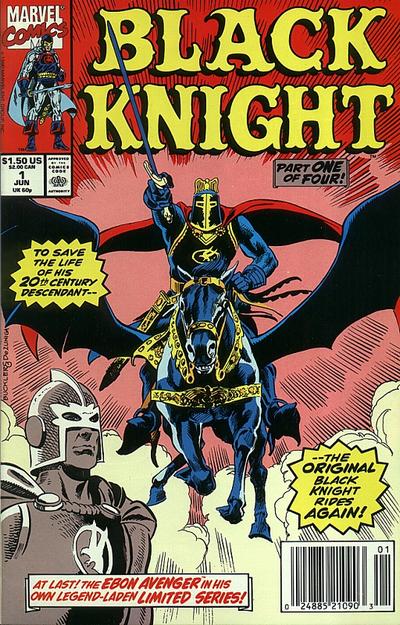 Sometime
later, Dane Whitman rejoined the Avengers for a lengthy stint, during
which time the Ebony Blade's curse caused him to be turned into a
living statue once again (this time made of metal). A four-issue
eponymously-titled miniseries (1990) told how Whitman's body was temporarily
re-animated by the spirit of his ancestor Sir Percy, the original
Black Knight. Sir Percy was called into battle once more against
Mordred and Morgan Le Fay (the latter of whom had been involved in
conflicts with Spider-Woman,
Iron Man, and
the Avengers
in recent years), who were attempting to conquer the world with black
magic. At the conclusion of this adventure, Sir Percy vacated Dane
Whitman's body to enter the Ebony Blade, freeing both man and weapon
from their curse.
Sometime
later, Dane Whitman rejoined the Avengers for a lengthy stint, during
which time the Ebony Blade's curse caused him to be turned into a
living statue once again (this time made of metal). A four-issue
eponymously-titled miniseries (1990) told how Whitman's body was temporarily
re-animated by the spirit of his ancestor Sir Percy, the original
Black Knight. Sir Percy was called into battle once more against
Mordred and Morgan Le Fay (the latter of whom had been involved in
conflicts with Spider-Woman,
Iron Man, and
the Avengers
in recent years), who were attempting to conquer the world with black
magic. At the conclusion of this adventure, Sir Percy vacated Dane
Whitman's body to enter the Ebony Blade, freeing both man and weapon
from their curse.
The Black Knight returned to the Avengers for several more
years,
and later served as the leader of an extradimensional group of
heroes, Ultraforce. Dane
Whitman
returned to his own dimension in the Black Knight: Exodus
special issue, and soon after, joined Iron
Fist and other Marvel heroes as a member of a new team,
Heroes
for Hire. In Heroes For Hire #2 (1997), Dane was
told by the
Lady of the Lake that he was to become the new champion of Avalon,
the Pendragon, and was given new magical weapons and a new winged
steed. (See the entries for the Knights
of Pendragon and Doctor
Strange for other Marvel treatments of the Pendragon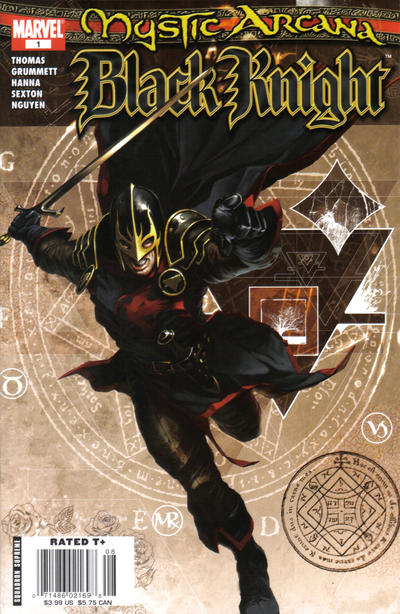 concept.) The Heroes for Hire series ended after
nineteen
issues; afterwards, the Black Knight returned to making occasional
appearances in Avengers.
concept.) The Heroes for Hire series ended after
nineteen
issues; afterwards, the Black Knight returned to making occasional
appearances in Avengers.
Dane Whitman was reunited with Captain Britain for a return to Otherworld in the 2001 Excalibur miniseries, and a few years later, both he and Sir Percy appeared in a three part story in issues 10-12 of the ongoing series New Excalibur (2006), "The Last Days of Camelot" told how Camelot fell before its appointed time, leaving Sir Percy as the sole survivor. The Lady of the Lake sent Percy's spirit to the 21st century, where he recruited Dane Whitman, along with Captain Britain and the rest of the Excalibur team, to travel back in time to set history straight, meeting Arthur, Merlin, and other traditional Arthurian figures in the process. During the course of the story, it was revealed that eight other knights of Arthur's court had held the Ebony Blade and served as the Black Knight prior to Sir Percy, but had been driven insane by its curse. (The story has been reprinted in a trade paperback collection, New Excalibur Vol. 2: Last Days of Camelot.)
In 2007, a somewhat different version of the Black Knight appeared in the 10th issue of Marvel Adventures: The Avengers, a title aimed at younger readers. This Black Knight championed the cause of Morgan Le Fay in an Avalon that magically appeared in the modern-day U.S. before being liberated by the Avengers. (The story has been reprinted in trade paperback in Marvel Adventures: The Avengers Vol. 3: Bizarre Adventures.)
Also in 2007, Marvel published four "one-shots" under the umbrella title of Mystic Arcana which spotlighted several of their magic-based characters. Together, these comics told a single story of a young sorcerer, Ian McNee, charged with saving all magic in the Marvel Universe. In Mystic Arcana: Black Knight #1, McNee encountered Morgan Le Fay in Avalon, and a flashback retold the origin and career of the original Black Knight, with notable new details that included the youthful Percy's having been chosen as a chanpion by Gwynn, a Celtic "hunter-spirit."
Following the cancellation of the New Excalibur
series, Dane Whitman rejoined Captain Britain yet again to become part
of a new British super-team, in Captain Britain and MI:13.
(This team's first adventure, "The
Guns of Avalon,"
is discussed in the Captain Britain enty
below.) After this title, too, was cancelled, the Black
Knight returned to making sporadic appearances throughout the Marvel
Universe, including in multiple issues of Avengers World (2014), in which he was shown leading a new super-team called Euroforce against Morgan Le Fay, and in Original Sins #2 (Aug., 2014), which picked up the New Excalibur story thread of Dane Whitman's struggle against the Ebony Blade's curse. This theme continued, though briefly, into a new Black Knight series in 2016; the series, which found Dane Whitman adventuring in an other-dimensional realm called Weirdworld, was unfortunately canceled after only five issues.
Earlier in the decade, in Black Knight (MDCU) #1 (2010), Marvel produced yet another version of the original Black
Knight's origin; in this new telling, it was revealed that the "Sir
Percy" readers had always known was in fact an imposter. Though
the peaceful and music-loving Percy of Scandia did indeed briefly hold
the Ebony Blade, he was quickly slain by servants of Mordred. His
place, however, was immediately taken by his braver and more
battle-ready twin brother Richard, who henceforth held not one secret
identity, but two -- not only that of the Black Knight, but of his own
late twin as well -- a ruse he thought would help confound Camelot's
enemies. (This story was orignially released in digital format
only, though it was later published as a hard-copy single issue comic
as well.)
In addition to Sir Percy and Dane Whitman, other known
wielders of the Ebony Blade have included Percy's
nephew Sir Raston -- a member of the Anachronauts
-- and a future version of the Black Knight who appeared in Solo
Avengers #4 (March, 1988). The May, 1997 issue of What If? presented a story of
another Black Knight, an immediate heir of Sir Percy who opposed
Marvel archvillain Dr. Doom in an alternate timeline (derived from
Iron Man v.1, #150)
in which Dr.
Doom had conquered Camelot. Black Panther v.4 #3
(June, 2005) introduced a
new, villainous Black Knight, who was described as a descendant of Lancelot.
Also on the Web:
Created by Chris Claremont (writer) and Herb Trimpe (penciller) in Captain Britain #1 (black and white, 1976, Marvel UK).
Key appearances (all published by Marvel UK except as noted):
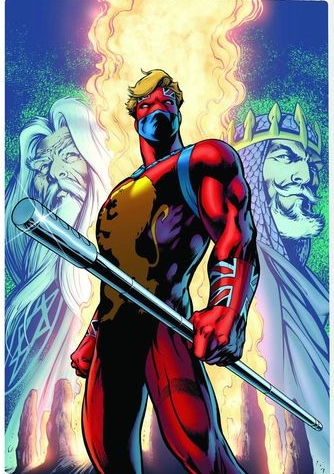
Marvel Comics' British publishing arm, Marvel UK, introduced
this
patriotic superhero in Captain Britain #1. (The
origin story
was reprinted for American consumption in Marvel Tales
#131-133.) Brian Braddock was a young graduate student who, while
fleeing from a dangerous criminal, found himself alone in the
countryside in a mysterious circle of stones identified as the
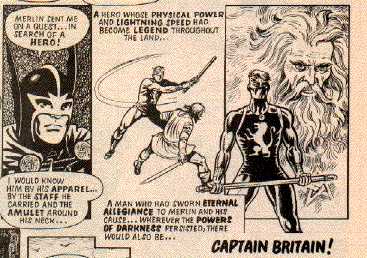 Siege
Perilous. Two apparitions calling themselves Merlin and the Lady of
the Northern Skies ( identified as Merlin's daughter Roma in later
stories) visited Brian and offered him a choice of either an amulet
or a sword (in a stone). Brian chose the amulet, a "symbol of life",
over the sword. Immediately he was struck by a bolt of energy which
transformed him into a superhuman champion of justice, an heir to the
Knights of the Round Table.
Siege
Perilous. Two apparitions calling themselves Merlin and the Lady of
the Northern Skies ( identified as Merlin's daughter Roma in later
stories) visited Brian and offered him a choice of either an amulet
or a sword (in a stone). Brian chose the amulet, a "symbol of life",
over the sword. Immediately he was struck by a bolt of energy which
transformed him into a superhuman champion of justice, an heir to the
Knights of the Round Table.
Captain Britain appeared in his own series from 1976 to 1977,
then
fell into obscurity when that series was cancelled. He resurfaced in
the Black Knight's
series in Hulk
Weekly suffering from amnesia. Brian Braddock joined the
Black
Knight in his adventures, eventually regaining his memory and
accompanying Dane Whitman to Otherworld, where he met Merlin (or
Merlyn) and Roma again, as well as King Arthur. The Black Knight's series ended soon afterward, but in 1981 Captain Britain was spun off into
his own new series in Marvel Super Heroes (later
moving to
The Daredevils, and then to The Mighty
World of
Marvel), receiving a new costume and modified powers in the
process. (All of these early adventures have been reprinted in two hardcover volumes by Marvel.)
series ended soon afterward, but in 1981 Captain Britain was spun off into
his own new series in Marvel Super Heroes (later
moving to
The Daredevils, and then to The Mighty
World of
Marvel), receiving a new costume and modified powers in the
process. (All of these early adventures have been reprinted in two hardcover volumes by Marvel.)
Captain Britain embarked on a memorable series of adventures (written by Alan Moore and illustrated by Alan Davis) involving multiple universes, each of which had its own version of the Captain. Merlyn was ultimately revealed as something more than the mage of Camelot or Otherworld -- he was the extremely powerful guardian of the multiverse, manipulating the actions of Brian Braddock and those around him in a effort to save reality. Merlyn was successful, but appeared to perish in the process, bequeathing his guardianship to Roma.
Following this story cycle (reprinted in trade paperback as Captain Britain, and in hardcover as Captain Britain Omnibus), the Captain
again received his own comic, which began in 1985 and ran for 14 issues (with scripts
now by Jamie Delano). In
1988 illustrator Davis
teamed with Captain Britain's co-creator Chris Claremont to create a
new super-team book featuring Brian Braddock, Excalibur.
Despite the title, Excalibur featured relatively
few Arthurian
references -- the series was a spinoff of Marvel's extremely popular
"X-Men," and the name appeared meant to evoke the
British
setting and the "X" connection simultaneously. Among the more
Arthurian storylines were: 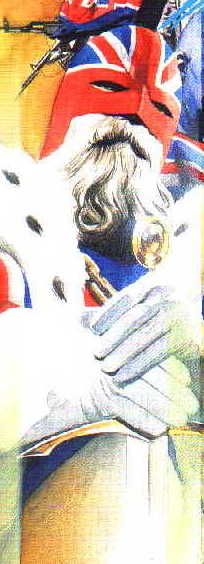 an
episode in which the Lady of the Lake summoned Iron
Man and the West Coast Avengers
to come to Excalibur's aid agains Doctor Doom (Excalibur
#37-38, May-June, 1991); Merlyn's return from his seeming death
(Excalibur: The Possession, July, 1991; Excalibur
#49-50, April-May, 1992); and a time-travel story in which one of the
original X-Men, Marvel Girl, having been transformed into "Marvel Le
Fey", attempted to steal Excalibur following Arthur's death
(Excalibur: XX Crossing, July, 1992). Merlyn also
appeared in
the series' final issue, #125 (October, 1998), according to Michael
Torregrossa's "Camelot
3000 and Beyond".
an
episode in which the Lady of the Lake summoned Iron
Man and the West Coast Avengers
to come to Excalibur's aid agains Doctor Doom (Excalibur
#37-38, May-June, 1991); Merlyn's return from his seeming death
(Excalibur: The Possession, July, 1991; Excalibur
#49-50, April-May, 1992); and a time-travel story in which one of the
original X-Men, Marvel Girl, having been transformed into "Marvel Le
Fey", attempted to steal Excalibur following Arthur's death
(Excalibur: XX Crossing, July, 1992). Merlyn also
appeared in
the series' final issue, #125 (October, 1998), according to Michael
Torregrossa's "Camelot
3000 and Beyond".
Concurrently with the early years of the Excalibur series, Captain Britain also appeared regularly in the first series of Knights of Pendragon, in which he embodied, for awhile at least, the eternal "Pendragon spirit" previously possessed by Lancelot.
In 1999 and 2000, Marvel presented Earth X, a miniseries describing an alternative future for Marvel's fictional universe. In this future, Brian Braddock has become King Britain, the ruler of the British Isles, while his teammates in Excalibur (now including the Black Knight) have been turned to stone. King Britain appears as well in two sequels, Universe X (2000) and Paradise X (2002). Issue # 2 of the former features appearances by Merlyn, Roma, and the Siege Perilous, while relating how Brian finally took possession of the "sword of power" first seen in his origin story -- here identified at last as the sword of King Arthur. At about the same time, Marvel published a new Excalibur miniseries (2001) which, though set in the present day, appeared to build on the concepts introduced in Universe X by featuring Captain Britain's quest for the sword Excalibur in Otherworld, joined by the Black Knight and others.
Later, in Avengers
v.3 #78-81 (2004), the identity of Captain Britain was passed on to a
new champion of Avalon. An Englishwoman named Kelsey Leigh was killed
while protecting Captain America. Kelsey's spirit journeyed to Avalon
in Otherworld, where she encountered Brian Braddock and his wife
Meggan (taking on the roles of Merlyn and Roma) and was given the
choice of amulet or sword. In choosing the sword, Kelsey was restored
to life as the new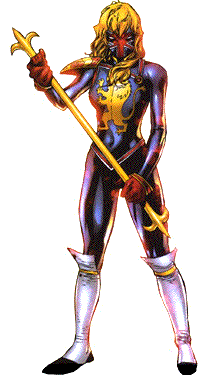 Captain Britain, but her choice also meant that
she could not reveal her return to her young children without causing
their deaths. The new Captain Britain fought Morgan Le Fay alongside
the Avengers and then accompanied them back to America to begin her
new life. She remained a member of the team until they disbanded soon
after in Avengers Finale (2004).
Captain Britain, but her choice also meant that
she could not reveal her return to her young children without causing
their deaths. The new Captain Britain fought Morgan Le Fay alongside
the Avengers and then accompanied them back to America to begin her
new life. She remained a member of the team until they disbanded soon
after in Avengers Finale (2004).
Brian Braddock resumed the role of Captain Britain in Uncanny X-Men #462 (2005) and formed a new Excalibur team in New Excalibur #1 (2006); Kelsey Leigh, now going by the name Lionheart, appeared in several issues of this series, beginning with #4. Soon after coming together, the team traveled through time with the Black Knight to avert "The Last Days of Camelot" (New Excalibur #10 - 12, 2006). Following the cancellation of their series with the 24th issue, New Excalibur joined with another X-Men spinoff teams, the Exiles, in the 5-issue miniseries X-Men: Die by the Sword (2007; reprinted in trade paperback in 2008). In this storyline, the allied heroes were attacked by a maddened Merlyn, and Roma was apparently killed.
Captain
Britain, joined by the Black Knight as well as other British-based
heroes, returned in a new series, Captain Britain and MI:13,
in 2008. In the initial four-chapter storyline "The Guns of
Avalon" (reprinted in trade paperback as Captain Britain and MI:13: Secret Invasion), alien invaders called Skrulls attempted to take control of all
magical power through an assault on Avalon. Merlyn, restored
to sanity as "Merlin the Wise," returned to assist Brian Braddock and
his allies, and Captain Britain wielded the sword Excalibur in battle
against the Skrulls' magical champion. Ultimately, the
invaders were repelled from Avalon and from Britain, and Excalibur
passed to a new superhero, Dr. Faiza Hussain, who took the sword's name as her own. The Captain Britain and MI:13
series continued on for several more storylines before meeting an
untimely end with the 15th issue. Brian Braddock has since
appeared sporadically in a variety of Marvel's comics, including
several Avengers titles and the "Revolutionary War"
limited-series crossover event of 2014. Dr. Faiza Hussain has
also borne the Captain Britain identity in a couple of
alternate-timeline stories, including Captain Britain and the Mighty Defenders (2015).
Also on the Web:
Created by Jack Kirby (writer and penciller) in The Demon v. 1, #1 (1972, DC Comics).
Key appearances:
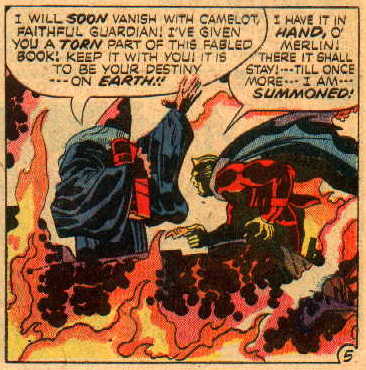
Jack Kirby (1917-1994) was perhaps the foremost mythographer of American comics. Drawing on Arthurian legend to create a new character, Kirby eschewed chivalry and romance and portrayed Camelot as a locus for ancient mystical forces. In a dramatic portrayal of the fall of Camelot in The Demon #1, the writer-artist told how forces commanded by Morgaine Le Fey attacked the legendary city, attempting to capture Morgaine's foe, Merlin, and seize his "Eternity Book". The powers of evil were opposed by a savage Demon in Merlin's service who held Morgaine at bay long enough for Merlin to cast a last spell and vanish with the Book. The Demon, Etrigan, also escaped, assuming the form of a mortal man and striding into the woods, never to be seen again -- until in the 20th century, a Gotham City demonologist named Jason Blood was summoned to Castle Branek in central Europe, where he discovered the tomb of the sleeping Merlin. Blood was actually the transformed Etrigan, unaware of his true identity until Merlin's spell again released the Demon to battle the immortal Morgaine, who was still seeking the Eternity Book.
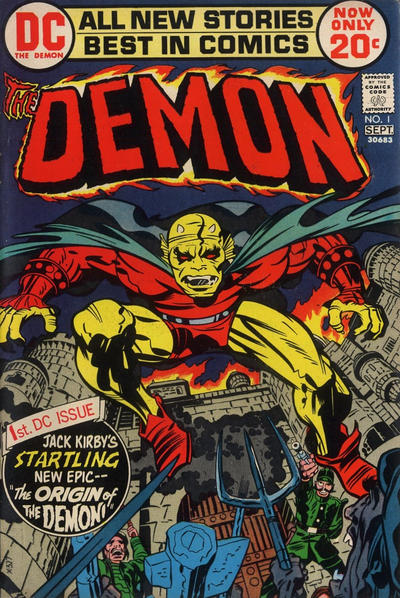 Morgaine
was defeated, apparently destroyed by Etrigan's "demonflame", and
Jason Blood tried to adjust to his new knowledge. Able to change into
Etrigan (and back again) by chanting Merlin's spell, Blood faced a
number of evil supernatural foes (most apparently inspired by old
Hollywood horror movies) over the sixteen-issue run of the series.
Merlin appeared frequently in the early issues, and Morgaine returned
in the final issue.
Morgaine
was defeated, apparently destroyed by Etrigan's "demonflame", and
Jason Blood tried to adjust to his new knowledge. Able to change into
Etrigan (and back again) by chanting Merlin's spell, Blood faced a
number of evil supernatural foes (most apparently inspired by old
Hollywood horror movies) over the sixteen-issue run of the series.
Merlin appeared frequently in the early issues, and Morgaine returned
in the final issue.
Like most comics heroes, the Demon's career did not end with his first series' cancellation. Jack Kirby never again wrote or drew a Demon tale, but over the decades a number of other talented creators have further developed his vision. For a brief period, Etrigan shared space with his fellow Gotham City resident, the Batman, in issues of Detective and Batman Family (Morgaine Le Fey appeared again in the latter's 17th issue, Apr.-May, 1978). Later, writer Alan Moore explored the Demon's nature as an literal fiend of Hell in Swamp Thing (issues published 1984 and later), portraying him as a genuinely sinister and frightening figure. This led into a 4-issue miniseries written and drawn by Matt Wagner, creator of Mage. Wagner drew on the traditonal story of Merlin's origins as told by Geoffrey of Monmouth to tell how Merlin, though born of a mortal woman, was sired by the demon Belial. Etrigan, as it happened, was also Belial's son -- Merlin's half-brother. Jason Blood was a mortal man whom Merlin had caused to be possessed by Etrigan. By the conclusion of this 1987 miniseries, Jason apeared to have freed himself from the Demon.
Etrigan's next major appearance was in his own series appearing in Action Comics Weekly (1989). Writer Alan Grant developed a tale that once again involved Morgaine Le Fey, with Merlin (now revealed as an unsympathetic manipulator) appearing as well. Etrigan became involved with political maneuverings in Hell as Grant approached the character and his milieu with a large amount of black humor. This approach was maintained as the Demon once again gained an ongoing title of his own. The use of the Arthurian mythos in this series centered on Merlin, although Sir Percivale made an appearance in issue 20. The series lasted for 59 issues (1990 - 1995), with later issues being written by Garth Ennis.
Sometime later,
in Wonder
Woman, writer-artist John Byrne evoked the tone and style of
the
original Jack Kirby stories in a sequence that found Etrigan
contending against Morgaine as she continued her quest for eternal
youth and beauty. (This 1995 - 1996 story arc was reprinted by DC in the trade
paperback Wonder Woman: Lifelines.) In later
(1997 - 1998) episodes of his Wonder Woman run, Byrne
revised much of the continuity that had been established for the Demon since Kirby
left the character, believing that these additions were untrue to
Kirby's conception. In many of Etrigan's subsequent appearances, however,
including the miniseries The Demon: Driven Out
(2003), DC's
writers seemed to ignore at least some of Byrne's
revisions. Byrne himself returned to the character in 2005 with the
short-lived series Blood of the Demon. This series
made
liberal use of Arthurian elements, with flashbacks to the Demon's
time in Camelot and battles against Morgaine Le Fey in the present
day. Following that series' cancellation, the Demon co-starred with Catwoman in a 12-part serial in Wednesday Comics (2009) in which Morgaine was again featured as the villain.
eternal
youth and beauty. (This 1995 - 1996 story arc was reprinted by DC in the trade
paperback Wonder Woman: Lifelines.) In later
(1997 - 1998) episodes of his Wonder Woman run, Byrne
revised much of the continuity that had been established for the Demon since Kirby
left the character, believing that these additions were untrue to
Kirby's conception. In many of Etrigan's subsequent appearances, however,
including the miniseries The Demon: Driven Out
(2003), DC's
writers seemed to ignore at least some of Byrne's
revisions. Byrne himself returned to the character in 2005 with the
short-lived series Blood of the Demon. This series
made
liberal use of Arthurian elements, with flashbacks to the Demon's
time in Camelot and battles against Morgaine Le Fey in the present
day. Following that series' cancellation, the Demon co-starred with Catwoman in a 12-part serial in Wednesday Comics (2009) in which Morgaine was again featured as the villain.
In 2011, DC relaunched its line of superhero comics under the brand name of "The New 52"), and Etrigan returned as the headliner of a new, ongoing series, Demon Knights, written by Paul Cornell (who had earlier scripted Captain Britain and MI:13 for Marvel). As implied by the title, however, the Demon here shared the spotlight with six other "heroes", Madame Xanadu and the Shining Knightamong
them. In many ways, this was Etrigan's most Arthurian
outing yet; the series was set during the early Middle Ages (though
four centuries after the fall of Camelot), and story arcs made liberal
use of the traditional characters and other elements of the legend,
including Merlin, Morgaine, and the Holy Grail. In this new,
"rebooted" continuity, Etrigan was a demon who had rebelled against
Lucifer, and Merlin was Lucifer's son (but probably not Etrigan's
brother, though this was never definitely stated one way or the other),
while Jason of Norwich was Merlin's mortal scribe, who was romantically
involved with Nimue (Madame Xanadu). Merlin magically bonded
Etrigan and Jason together so that when Etrigan was on Earth, Jason had
to take his place in Hell, and vice versa. After the fall of
Camelot, Jason/Etrigan traveled the world with Madame Xanadu (the lover
of them both), searching for Merlin and an end to their curse. In
issue #9, the Demon Knights did in fact catch up with Merlin, only to
find that he had just been (apparently) murdered. As things
turned out, however, Merlin's life could be restored if his body was
taken to the realm of Avalon, so the Knights traveled to Avalon by way
of the ruined remains of Camelot, at which they encountered a
dessicated, "undead" King Arthur (linking this series with several
other Arthurian-zombie comics mash-ups appearing at approximately the
same time -- see Dead Future King, Knights of the Living Dead, and Knights of Pendragon in Part Two).
A soon-rejuvenated Arthur then teamed with Etrigan and the other
Knights to fight a battle in Avalon that involved both Morgaine Le Fay
and Lucifer, ultimately ending with the successful revival of
Merlin (and the suggestion of an unexpected connection with the 21st century superhero team Stormwatch). Following this story arc, Cornell was succeeded as writer
by Robert Venditti, andthe series leaped forward in time 30 years into
a new storyline concerning an invasion of Europe by a horde of
vampires, and the Demon Knights' quest for the Holy Grail. The
series concluded with the 23rd issue, having presented some colorful,
entertainting tales along the way, but never seeming to completely
fulfill its promise. (The entire series has been collected in a
series of three trade paperbacks.)
The Demon has appeared in a wide variety of other comics beyond those mentioned here, including a number with substantial Arthurian content. (See the entries for Batman, Justice League, Superman, and Swamp Thing in Part Four, as well as the reference to The Janissary below.)
Also on the Web:

French.
Created by Daniël Jacquette Rodolphe
(writer) and Michel Rouge (artist). Published in seven volumes by
Glenat, 1983-1994. (Two omnibus reprint volumes were published in
2009-2010.)
Robert Vermaat writes: "Gwen, a young boy, thinks he is the son of peasants. But then a witch tells him he is in fact the only son of Morgane [le Fay] and the god Taranis. He is also a grandson of Gralon, king of Brittany. Hunted by his uncle Reynaud, Gwen has to stay alive to gain the throne. This is the start of many adventures, that will bring him a crown, but also deep misery and the death of his loved ones, before he finds peace.
"Though the story is clearly
fifth-century, the
setting is medieval, which is a pity. The Arthurian influence is
remote, but gets stronger when volume 4 (Avalon) is
reached.
This is when Gwen is captured by the Picts and dies in prison, after
which he is transported to Avalon by his girlfriend Elaine, who turns
out to be the daughter of King Arthur! He stays and meets all the
great Arthurian characters, until he and Elaine decide to return to
the land of the living. They lose their memories as a punishment for
that. This is also the end of the Arthurian angle, for the remaining
three volumes are set in a totally different background." (Sources for publication information: Amazon.fr, Bedetheque)
First appeared in National
Comics #1 (1940, Quality Comics), in a story drawn (and possibly written) by Dan Zolnerowich (as Lance Blackwood). 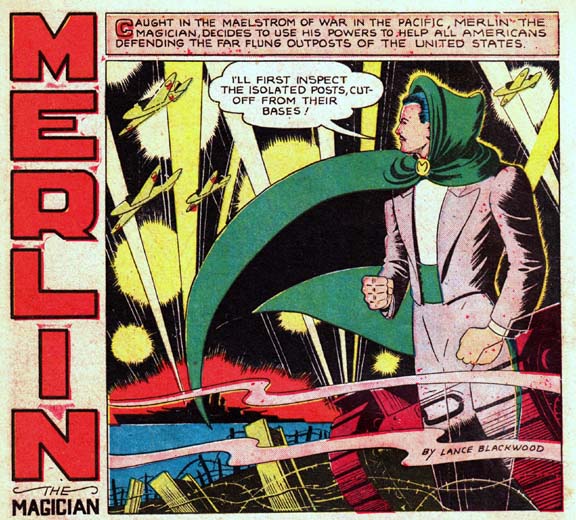
Key appearances:
Quality Comics' Merlin was a descendant of the Merlin of
King
Arthur's time, who used his sorcerous
powers to battle Nazis. Like a number of other comic book magicians of
the era, Merlin appears to have been modeled after Lee
Falk's successful comic-strip hero "Mandrake the Magician", sporting
a similar "stage magician" look (suit, cape, and moustache). In
later years, Merlin's adventures were written and drawn by Fred
Guardineer, whose work appears at right.
After many years' absence from publication, Merlin appeared in a new story of the Justice Society of America (All-Star Comics v. 2, #1, May, 1999) that related the previously-untold tale of his death in battle in 1945.
Created by Mark Wayne Harris (writer) and Nicholas Koenig (penciller) in MerlinRealm 3D, Blackthorne 3D Series #2 (1985, Blackthorne Publishing).
According to the text introduction to this one-shot comic, in
the
final days of our universe Merlin woke from his long sleep and
created a new world, based on magic, which he came to rule. Some
years later Merlin vanished and his son, Prince Seth, returned to
Merlincastle to attempt to take the throne. But the realm was in
chaos, and the prince became a wanderer, one of the most powerful
black magicians in the land. The comic (printed with a
three-dimensional process) related one sorcerous advenure of Seth
Merlinson. The character subsequently appeared two more times, in Blackthorne 3 in 1 #1 & 2 (1986-87); the second issue revealed that his mother was Morgaine le Fay. (Source for Blackthorne 3 in 1 information: Daniel Nastali.)
Created by Marv Wolfman (idea), Bill Mantlo (script), and Yong Montano (pencils) in Marvel Chillers #1 (1975, Marvel Comics).
Key appearances:
Modred the Mystic (not to be confused with Arthur's villainous
nephew Sir Mordred or Modred) was featured in the two sole issues of
Marvel Chillers and shared star billing with the
Thing in
Marvel Two-In-One #33. Modred was a wizard's
apprentice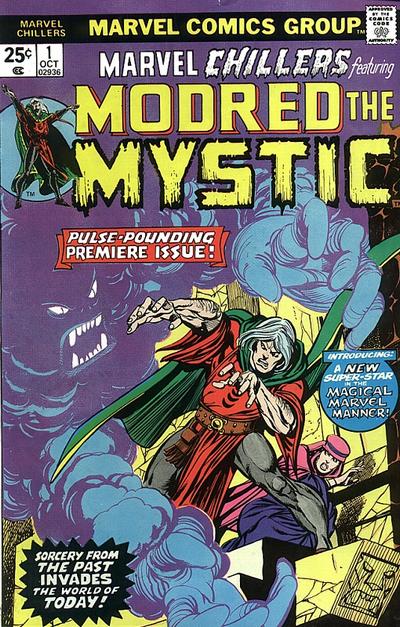 who
resisted King Arthur's command to join the students of Merlin at
Camelot. (This Merlin was later revealed to be an impostor, an evil
mutant called the Maha Yogi.)
Attempting to quickly gain enough magical power to thwart Merlin, Modred
tried to learn the secrets of an ancient book of sorcery called
the Darkhold. Modred was
struck down by
the Darkhold's black magic and cast into suspended animation until
awakened in the 20th century by two archaeologists. The wizard
learned he had inherited great power from his encounter with the
Darkhold, but he was almost immediately attacked by "The Other", a
demonic personification of the grimoire's evil. Apparently defeating
the Other in Marvel Chillers #2, Modred then
resisted the
efforts of demons supposedly dispatched through time by Merlin to
retrieve him in Marvel Two-In-One #33.
Unfortunately, the
Mystic's next appearance (Avengers
#185-187; reprinted in black & white paperback format in
Backpack Marvels: The Avengers: Nights of Wundagore and in color as Avengers: Nights of Wundagore)
revealed
that far from defeating the Other, Modred had actually been secretly
possessed by the entity, and had now become a servant of Chthon, the
Elder God who had created the Darkhold as his touchstone with our
world when he was banished from our universe. Modred was defeated by
the Avengers in his attempt to raise Chthon, but later returned to
battle Captain America, Captain
Britain, and others, and to make recurring appearances in the
short-lived series Darkhold: Pages From the Book of Sins.
Modred remains possessed by the evil of the Darkhold (which itself
has figured prominently in several Marvel Comics stories featuring
Morgan Le Fey in battle with Spider-Woman,
Iron Man, and the
Avengers).
who
resisted King Arthur's command to join the students of Merlin at
Camelot. (This Merlin was later revealed to be an impostor, an evil
mutant called the Maha Yogi.)
Attempting to quickly gain enough magical power to thwart Merlin, Modred
tried to learn the secrets of an ancient book of sorcery called
the Darkhold. Modred was
struck down by
the Darkhold's black magic and cast into suspended animation until
awakened in the 20th century by two archaeologists. The wizard
learned he had inherited great power from his encounter with the
Darkhold, but he was almost immediately attacked by "The Other", a
demonic personification of the grimoire's evil. Apparently defeating
the Other in Marvel Chillers #2, Modred then
resisted the
efforts of demons supposedly dispatched through time by Merlin to
retrieve him in Marvel Two-In-One #33.
Unfortunately, the
Mystic's next appearance (Avengers
#185-187; reprinted in black & white paperback format in
Backpack Marvels: The Avengers: Nights of Wundagore and in color as Avengers: Nights of Wundagore)
revealed
that far from defeating the Other, Modred had actually been secretly
possessed by the entity, and had now become a servant of Chthon, the
Elder God who had created the Darkhold as his touchstone with our
world when he was banished from our universe. Modred was defeated by
the Avengers in his attempt to raise Chthon, but later returned to
battle Captain America, Captain
Britain, and others, and to make recurring appearances in the
short-lived series Darkhold: Pages From the Book of Sins.
Modred remains possessed by the evil of the Darkhold (which itself
has figured prominently in several Marvel Comics stories featuring
Morgan Le Fey in battle with Spider-Woman,
Iron Man, and the
Avengers).
Also on the Web:
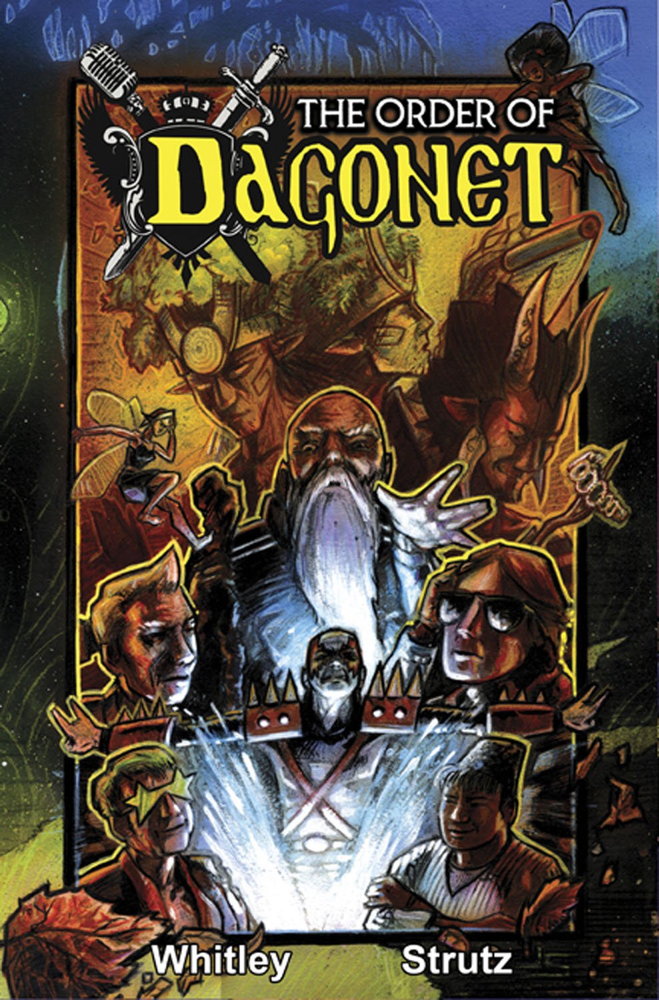 Created by writer Jeremy Whitley (writer) and illustrator Jason Strutz (artist) in The Order of Dagonet #1 (2009, Firetower Studios).
Created by writer Jeremy Whitley (writer) and illustrator Jason Strutz (artist) in The Order of Dagonet #1 (2009, Firetower Studios). Created by Barry Blair (writer and artist) in Pendragon #1 (1991, Aircel Comics, a division of Malibu Graphics Publishing Group).
The first issue of this black-and-white comic book introduces Valerie Pender, a modern New York University student who is the last of the Pendragon line. She is menaced by Mordred and aided by Merlin (her college professor) who gives her Excalibur (and an improbably skimpy outfit) with which to battle evil. The series ran for only two issues.
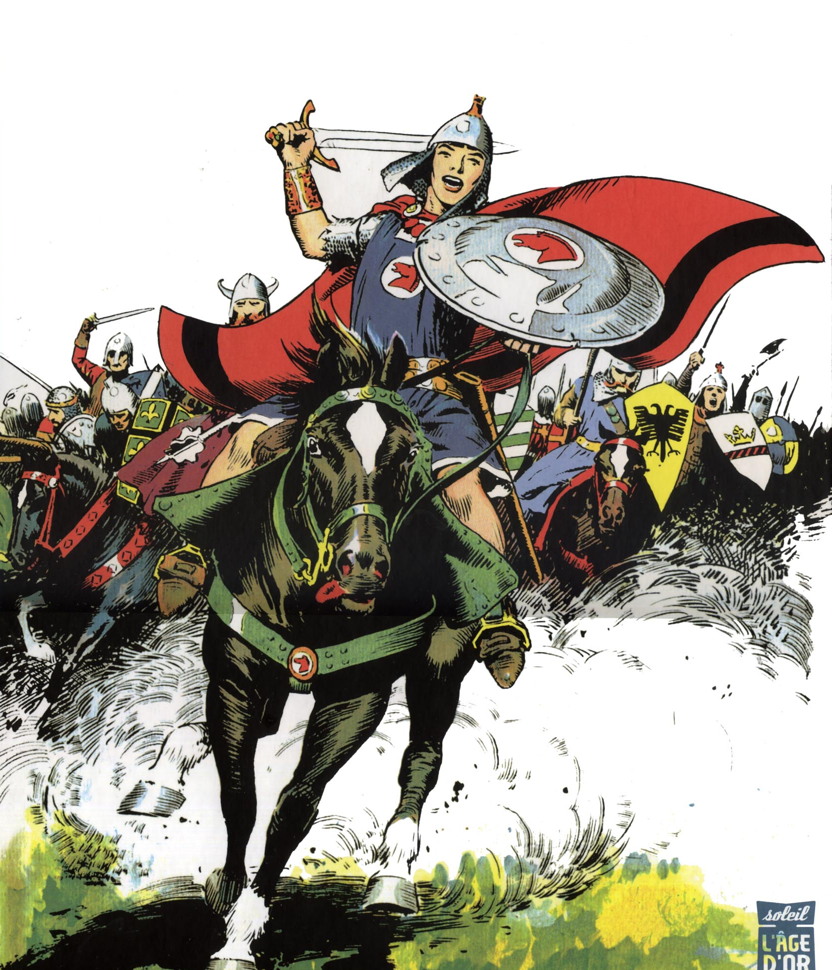 Created by Harold R. (Hal) Foster in "Prince Valiant in the
Days
of King Arthur?" (1937, syndicated to newspapers by King Features
Syndicate).
Created by Harold R. (Hal) Foster in "Prince Valiant in the
Days
of King Arthur?" (1937, syndicated to newspapers by King Features
Syndicate).
Key appearances:
"Prince Valiant" newspaper strip, appearing each Sunday from Feb. 13, 1937 to the present
"Prince Valiant" in Four Color #567, 650, 699, 719, 788, 849, 900 (1954-1958, Dell Publishing Co.)
Prince Valiant #1-4 (1994-1995, Marvel Comics)
King: Prince Valiant # 1 (2015, Dynamite Comics)
Without a doubt, "Prince Valiant" is the best-known Arthurian comics work in the world. For over 60 years, Sunday newspaper comics sections have presented the continuing adventures of Valiant, Prince of Thule and Knight of the Round Table.
Valiant's saga begins in his childhood, as his father, King
Agnar
of the mythical Nordic land of Thule, flees with his family from a
usurper to find refuge in Britain. Val grows up on a desolate island
in the midst of a vast marshland. While still a
youth,he decides to leave home and, reminiscent of Perceval in
medieval romances, puts together some makeshift arms and sets out to
become a knight. Quickly he encounters Sir 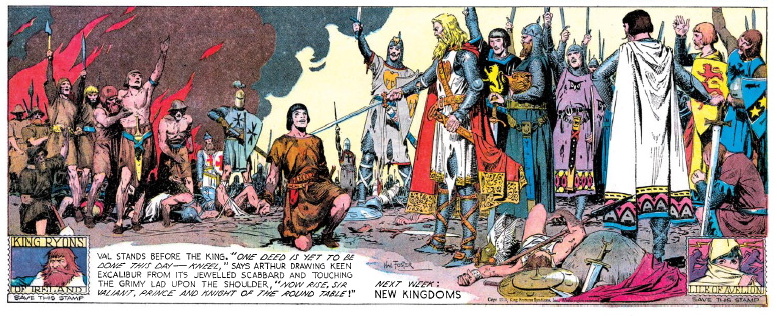 Lancelot and, a bit later,
Sir Gawain, with whom he joins company and whose squire he eventually
becomes. After several adventures, Valiant arrives with Gawain at
Camelot, "the city of marvel", and meets Arthur, Guinevere, and
Merlin. Over the next few years the brave but occasionally rash young
Valiant has a number of adventures as Gawain's squire and eventually
wins a place as a Knight of the Round Table. Later, he meets and
falls in love with Aleta, Queen of the Misty Isles; they wed, and
have several children (the oldest of whom has made Valiant a
grandfather in the strip's recent years).
Lancelot and, a bit later,
Sir Gawain, with whom he joins company and whose squire he eventually
becomes. After several adventures, Valiant arrives with Gawain at
Camelot, "the city of marvel", and meets Arthur, Guinevere, and
Merlin. Over the next few years the brave but occasionally rash young
Valiant has a number of adventures as Gawain's squire and eventually
wins a place as a Knight of the Round Table. Later, he meets and
falls in love with Aleta, Queen of the Misty Isles; they wed, and
have several children (the oldest of whom has made Valiant a
grandfather in the strip's recent years).
Valiant, like many traditional Arthurian heroes, is emotional and sensitive as well as courageous and strong; unlike many of them, he is able to find personal contentment with his wife and family. Hal Foster was not interested in the medieval notion of courtly love, or in the chastity of a Galahad. It is not coincidental that Foster married Val and Aleta in 1946, at the beginning of the postwar baby boom; the hero reflects the concerns and preoccupations of his time.
Throughout the ongoing epic, the Arthurian setting has often remained in the background, as Valiant has travelled far from the British Isles; his journeys have taken him to Africa, India, and North America, as well as other locales not usually associated with the legends of Camelot. At other times, the Arthurian material has come to the forefront, as Val has encountered Morgan Le Fey, searched for the Holy Grail, or fought in the Battle of Badon Hill. Valiant has also struggled to foil the schemes of Sir Modred (whose daughter Valiant's son Arn eventually marries).
Hal Foster's greatest achievements probably lie in his amazing draftsmanship and in the versimillitude with which he invests his romantic version of history. Foster writes (and draws) of a glorious medieval Camelot which never truly existed, but the facts of fifth-century history which he draws upon for his story (Genseric's sack of Rome, for example), combined with his meticulous detailing of armor, dress, and other elements from several different centuries, lend an authenticity that makes both his historical amalgam of a setting and the often larger-than-life deeds of his heroes plausible.
Though
"Prince
Valiant" will always be identified with its creator, a number of
other artists and writers have also worked with the character. From
1971 until 2004, the strip was drawn by John Cullen Murphy. Foster
stopped writing the
strip in 1980, two years before his death at the age of 89, and was
succeeded as writer by Cullen Murphy, the illustrator's son. John
Cullen Murphy retired in 2004, passing the illustration duties to Gary
Gianni; the strip is now scripted by Mark Schultz. There have 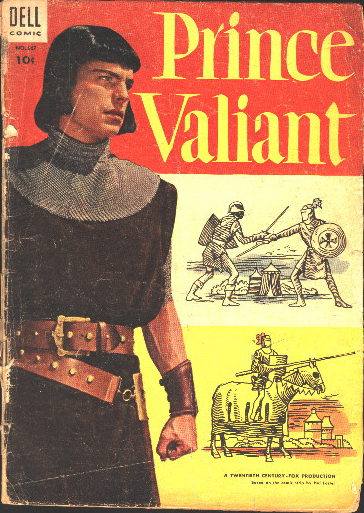 also been
two versions (not counting strip
reprints) produced for comic books. One was published in the 1950's
by Dell; the
second, a
four-issue miniseries published by Marvel Comics in 1994 and 1995, is
one of the most Arthurian "Prince Valiant" stories
also been
two versions (not counting strip
reprints) produced for comic books. One was published in the 1950's
by Dell; the
second, a
four-issue miniseries published by Marvel Comics in 1994 and 1995, is
one of the most Arthurian "Prince Valiant" stories yet
to be created. Written by Charles Vess and Elaine Lee and
illustrated by John Ridgway, the story is conceived as a sequel both
to the ongoing continuity of the newspaper strip and to the
traditional Arthurian legend. Following the deaths of Arthur and
Modred on the battlefield, the sorceress Queen Morgause, Arthur's
sister and the mother of Modred and Gawain, steals Excalibur and
kidnaps Ingrid, the granddaughter of both Modred and Valiant, in a
bid to seize power. Valiant, aided by Merlin and the wizard's protege
Nimue, as well as his other family members and familiar companions
from the newspaper strip, must follow Morgause to the Scottish
islands of Orkney to rescue both his granddaughter and his son Galan
and to save Britain from the evil witch. More recently, in 2015
Dynamite Comics began publication of a four-issue miniseries under
the title of King: Prince Valiant,
which for the first time teams the character with other comic strip
heroes licensed by King Features Syndicate, including Flash Gordon and
Mandrake the Magician.
yet
to be created. Written by Charles Vess and Elaine Lee and
illustrated by John Ridgway, the story is conceived as a sequel both
to the ongoing continuity of the newspaper strip and to the
traditional Arthurian legend. Following the deaths of Arthur and
Modred on the battlefield, the sorceress Queen Morgause, Arthur's
sister and the mother of Modred and Gawain, steals Excalibur and
kidnaps Ingrid, the granddaughter of both Modred and Valiant, in a
bid to seize power. Valiant, aided by Merlin and the wizard's protege
Nimue, as well as his other family members and familiar companions
from the newspaper strip, must follow Morgause to the Scottish
islands of Orkney to rescue both his granddaughter and his son Galan
and to save Britain from the evil witch. More recently, in 2015
Dynamite Comics began publication of a four-issue miniseries under
the title of King: Prince Valiant,
which for the first time teams the character with other comic strip
heroes licensed by King Features Syndicate, including Flash Gordon and
Mandrake the Magician.
The "Prince Valiant" newspaper strips by Hal Foster have been
reprinted in a number of editions in several languages, with Pacific
Comics Club and Manuscript
Press among the English-language publishers. Fantagraphics
Books
has released 40 color trade paperback volumes including
all
the strips written and illustrated by Foster from 1937 to 1971; the
same publisher began to release a new series of hardcover reprints in
2009.. Two
black-and-white paperbacks reprinting
John Cullen and Cullen Murphy material were published by Blackthorne
Publishing in 1986, and Andrews McMeel released a collection of Gianni
and Schultz strips in 2008.
Valiant has appeared in other, non-comics media as well. A series of books adapting Foster's narrative to an illustrated novel format were published by Nostalgia Press in the 1970's. The motion picture Prince Valiant, directed by Henry Hathaway and starring Robert Wagner and Janet Leigh, was released by 20th Century Fox in 1954 and is available on DVD. A new film version, also simply titled Prince Valiant, was released in 1997 by Paramount. This version starred Stephen Moyer and Katherine Heigl and was directed and co-written by Anthony Hickox, who also played Gawain; it too is available on DVD. In addition, an animated series called The Legend of Prince Valiant, featuring the voices of Robby Benson, Tim Curry, and Samantha Eggar, aired on the cable network The Family Channel from 1991 to 1992.
(Sources for some publication information: The Overstreet Comic Book Price Guide and The World Encyclopedia of Comics. Additional sources for film and television information: The Internet Movie Database; and Kevin J. Harty's "Arthurian Film" and Michael N. Salda's "Arthurian Animation", both from the Arthuriana / Camelot Project Bibilographies series.)
Also on the Web:

Dutch.
First appearance in PEP #1-16 (1970).
Key appearances (all published in the Netherlands):
Robert Vermaat writes: "Ridder Roodhart (Sir Redhart), a (very) handsome though sometimes dim knight, is the only one that can regain the vanished Round Table for King Arthur [in De Strijd om de Ronde Tafel]. Dashing forth into the adventure, he and his loyal friend Bombardon must defy the black magic of Mordred and regain the treasure. Luckily, where all other knights run off without using any brain cells whatsoever, Merlin keeps cool and can assist the heroes in their hour of peril. Only, when all knights are saved and the Round Table regained, Roodhart steals it to return to Camelot alone and claim all the glory! Not so dim after all." De Strijd om de Ronde Tafel, released by Publisher Oberon in 1978, was the third Ridder Roodhart volume written by Lo Hartog van Banda and illustrated by Dick Matena. Although Roodhart is a knight of the Round Table, the amount of Arthurian material in the first two albums is uncertain.
Created by Creig Flessel (artist) and ? (writer) in Adventure
Comics #66 (1941, DC Comics).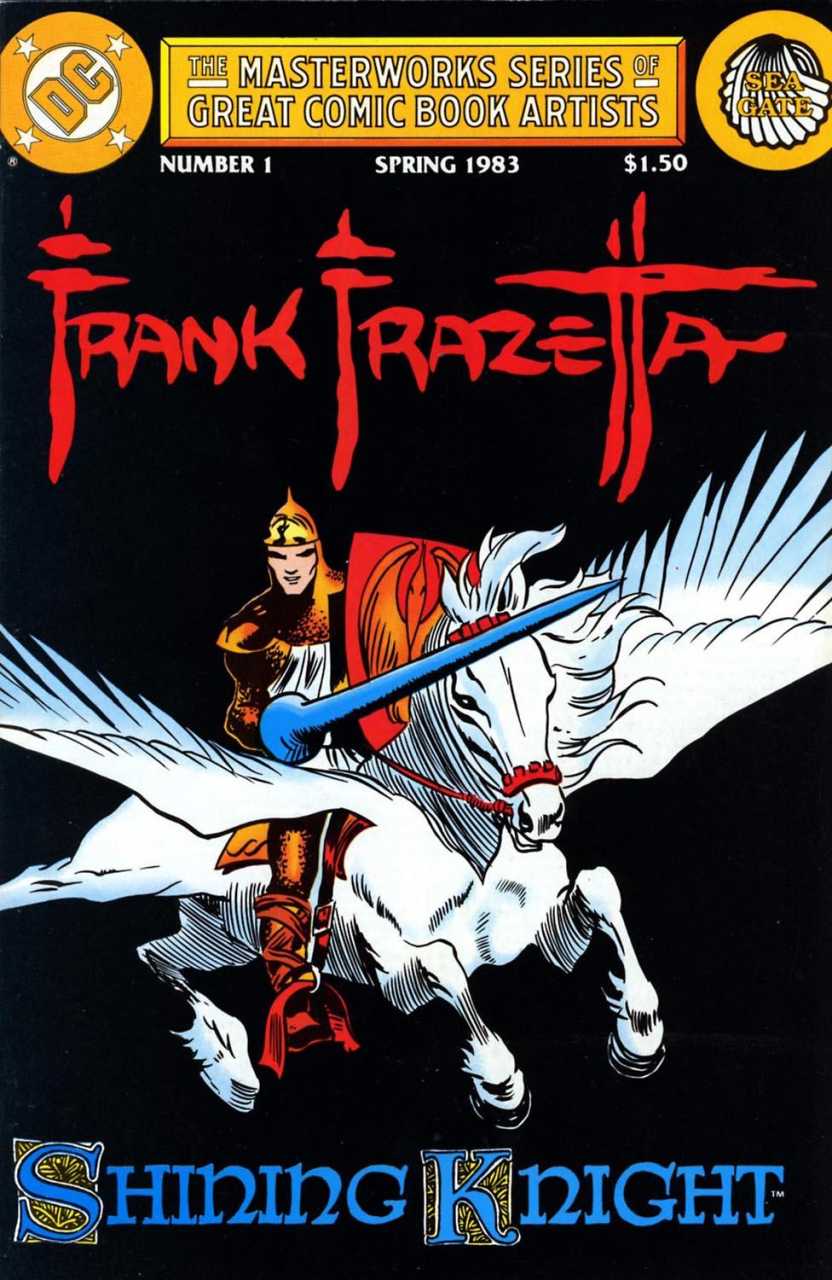
Key appearances:
Like Prince Valiant and the original Black Knight, the Shining
Knight is a Knight of the Round Table created for the comics. Sir
Justin had the good fortune to possess an enchanted sword and suit of
mail, as well as a winged horse named Victory, all given him by
Merlin. He also had the poor fortune to fall into an icy crevasse
while battling a giant, and to be frozen in suspended animation until
the 20th Century. Thawed out in the 1940's, Sir Justin took up the
Arthurian battle for justice as a superhero. He assumed the civilian
guise of the assistant director of a museum, his true identity known
only to a boy sidekick, "Sir Butch". Justin's reactions to
contemporary mores and customs were sometimes played for humor.
 The
series occasionally featured flashbacks to his exploits in Camelot
(where, also like Valiant and Percy, he opposed Sir Mordred) and
after some time the Shining Knight gained the ability to travel
between the two eras via Merlin's magic.
The
series occasionally featured flashbacks to his exploits in Camelot
(where, also like Valiant and Percy, he opposed Sir Mordred) and
after some time the Shining Knight gained the ability to travel
between the two eras via Merlin's magic.
Among the artists who illustrated Sir Justin's adventures was a young illustrator named Frank Frazetta, later to become famous as a fantasy painter. (Several of Frazetta's stories were collected and reprinted by DC Comics in the 1980's in two issues of The Masterworks Series of Great Comic Book Artists; the cover of the 1st issue appears to the right, while another sample of Frazetta's work appears to the left.)
The Shining Knight eventually joined a team of American
superheroes, the Seven Soldiers of Victory (or "Law's Legionnaires"),
who appeared in Leading Comics for about five
years. Sir
Justin's own series ended in the early 1950's, but DC revived him and
his fellow Soldiers of Victory in 1972, in the pages of Justice
League of America. The Shining Knight's appearances since
then
have been sporadic, however. He made semi-regular appearances in
All-Star
Squadron
(a series set during the 1940's, but published in the 1980's).
Episodes of particularly Arthurian interest included the story of a
false "Camelot 1942" arising in England (issues #48-49, 1985) and a
retelling of Sir Justin's origin in issue #62 (1986). The Shining Knight has
also been used interestingly in several tales of various DC characters' trips through time to Camelot. Among these have been a
Justice Society of America story (All-Star Comics #64-65, 1977)
illustrated
by Wally Wood (who illustrated Arthurian stories in EC Comics'
Valor and who also worked briefly on "Prince
Valiant"), as
well as an adventure of Swamp
Thing which is discussed in in Part
4
of this survey. More
recently,
Sir Justin appeared in Stars and S.T.R.I.P.E.
(issues #9
through #13, 2000), battling the Dragon King (see the All-Star
Squadron entry, also in Part
4), and
with the remaining Seven Soldiers in JSA #50 (2003).
characters' trips through time to Camelot. Among these have been a
Justice Society of America story (All-Star Comics #64-65, 1977)
illustrated
by Wally Wood (who illustrated Arthurian stories in EC Comics'
Valor and who also worked briefly on "Prince
Valiant"), as
well as an adventure of Swamp
Thing which is discussed in in Part
4
of this survey. More
recently,
Sir Justin appeared in Stars and S.T.R.I.P.E.
(issues #9
through #13, 2000), battling the Dragon King (see the All-Star
Squadron entry, also in Part
4), and
with the remaining Seven Soldiers in JSA #50 (2003).
In 2005 and 2006, British writer Grant Morrison presented a new take on the "Seven Soldiers" concept with a series of overlapping, interconnected miniseries that recounted the struggle of seven individual champions against an invading menace from the future, the Sheeda. A new version of the Shining Knight was introduced as one of these Soldiers, who never actually met face-to-face. This Shining Knight was a teenager named Ystin, the last "Knight of the Broken Table," who battled the Sheeda at the fall of Camelot 10,000 years ago (in Morrison's conception, an Arthur emerges at various times throughout history). Ystin arrived in 21st century Los Angeles aboard the flying Sheeda fortress, Castle Revolving, accompanied by the winged horse Vanguard, to continue the battle against Camelot's destroyers. References to Arthurian legend and Celtic mythology appeared throughout the miniseries, and (to a lesser extent) through the whole overarching "Seven Soldiers" epic; Morrison even went so far as to link the core concept with the medieval Welsh poem Preiddeu Annwn (The Spoils of Annwn), which describes an Otherworld journey of Arthur and three shipfuls of companions: "Except seven, none returned from Castle Revolving." Morrison's ambitious "megaseries" of superheroes, magic, monsters, aliens, and gods remains one of the most original and imaginative reworkings of Arthurian legendary materials in recent American comics.
Morrison's new version of the Shining Knight was carried forward with few modifications into DC's new fictional continuity, "The New 52", in 2011, appearing as a regular character through the 23 issues of the medieval super-team series Demon Knights alongside fellow Arthurian characters Etrigan the Demon and Madame Xanadu.
This series reiterated the idea that there had been a number of
Camelots throughout history, and a number of Arthurs as well (though
apparently only one, essentially immortal Merlin, who, like T.H.
White's version and Cagim, grows
younger as time passes). At the time Ystin's Camelot fell, the
knight had been charged by Merlin with the quest of the Holy Grail;
this quest dominated the latter half of the series' run, and was
ultimately achieved in the final two issues.
Also on the Web:
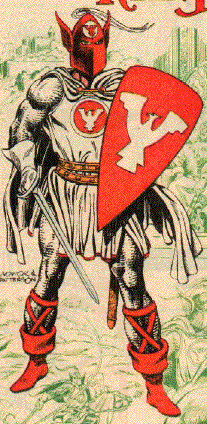
Created by Robert Kanigher (writer) and Irv Novick (artist) in The Brave and the Bold #1 (1955, DC Comics).
Key appearances:
The Silent Knight was a medieval hero who appeared in early
issues
of DC Comics' The Brave and the Bold in the 1950's.
Brian Kent
was the teenage son of Sir Edwin Kent, a knight who ruled a small
kingdom somewhere in Britain with another knight, Sir Oswald Bane.
After Sir Oswald treacherously caused Sir Edwin's "accidental" death,
Brian became Oswald's ward. One day, while pursuing Oswald's escaped
falcon into the nearby Forest Perilous, Brian found a suit of armor.
Donning this armor, Brian became the 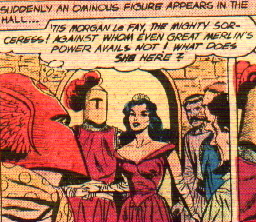 Silent
Knight, who battled against Oswald's tyrannical rule. The Silent
Knight never spoke lest he be recognized as Brian Kent. (Note: The
retelling of the Silent Knight's origin story in a 1990 issue of
Secret Origins presented Brian as a stable boy
rather than
Edwin's son.) The earliest Silent Knight stories were not given a
specific chronological setting, but the Knights of the Round Table
appeared in The Brave and the Bold #10, and eight
more stories
with Arthurian elements appeared before the series ended in issue #
22. (Source: Arthurian bibliographer Dan Nastali.)
Silent
Knight, who battled against Oswald's tyrannical rule. The Silent
Knight never spoke lest he be recognized as Brian Kent. (Note: The
retelling of the Silent Knight's origin story in a 1990 issue of
Secret Origins presented Brian as a stable boy
rather than
Edwin's son.) The earliest Silent Knight stories were not given a
specific chronological setting, but the Knights of the Round Table
appeared in The Brave and the Bold #10, and eight
more stories
with Arthurian elements appeared before the series ended in issue #
22. (Source: Arthurian bibliographer Dan Nastali.)
The character has appeared only sporadically since the 1950's. In the 1990's, the Silent Knight was revealed in DC's third Hawkman series to have been an avatar of the "Hawk God;" more recently, in the latest Hawkman series it has been implied that the Knight is an earlier incarnation of the current Hawkman, Carter Hall. In The Brave and the Bold v.3, #10 (2008), Merlin brought Superman back in time for an adventure with Brian Kent (revealed to be an ancestor of Superman's adoptive father). An entirely different version of the Silent Knight appeared briefly in Seven Soldiers: Shining Knight #1 (2005), identified as Sir Gawain (also known as Gwalchmai, which means "hawk of May"in Welsh).
Also on the Web:
Created by ? in Robin Hood v. 1 #52, (1955, Magazine Enterprises).
Dan Nastali has described this feature as "truly mediocre period stuff." Sir Galant's stories appeared as a secondary feature in Robin Hood v. 1 #52 & 53, and v.2 #1-8 (1955-57). Mr. Nastali also notes: "The final three issues of the comic book itself were titled The Adventures of Robin Hood to associate it with the TV series starring Richard Greene, whose photographs in character were used as cover illustrations. Frank Bolle was the artist on most stories, and the influence of "Prince Valiant" extends to clear swipes from Hal Foster's art. Bob Powell drew the final three stories. Evil knights, Saracens, and Vikings supplied the conflict in these stock medieval adventures, and Arthurian elements, such as the appearance of Merlin, were infrequent." (Additional sources: The Overstreet Comic Book Price Guide; Michael Torregrossa.)
 Created by Robert Place Napton (witer) and Zid (artist) in Son of Merlin #1 (2013, Image Comics).
Created by Robert Place Napton (witer) and Zid (artist) in Son of Merlin #1 (2013, Image Comics).
Simon Ambrose, a brilliant scientist and professor at MIT, discovers that he is the illegitimate son of the recently slain wizard Merlin, and the heir to his powers of Druidic magic. In a five-issue miniseries (also reprinted in trade paperback), Simon must set aside his skepticism and learn how to wield his sorcerous might in time to save the world from Merlin's ancient foe, the witch Morgana La Fey.
The plot moves swiftly, if predictably, and the photorealistic-style
painted illustrations are appealing, making this a pleasant if not
outstanding read. From an Arthurian standpoint, the most
innovative elements are the characterization of Morgana's son Ywain,
usually portrayed as a heroic knight, as his mother's willing
accomplice in evildoing, and the use of the Stone of Giramphiel, a
magical artifact from the medieval German Arthurian romance Diu Krône ("The Crown") that is rarely if ever seen in modern Arthuriana, as the key driver of the storyline.
Created by ? in Captain Courageous Comics
#6, (1942,
Periodical House / Ace Magazines). 
Key appearances:
This obscure 1940's character, little remembered today, was one of the earliest superheroes inspired by the Arthurian legend to appear in American comics (following Merlin the Magician and the Shining Knight). According to Pure Excitement Comics, the Sword was young Arthur Lake, who secretly kept the magic sword Excalibur embedded in a stone. Whenever Arthur pulled the sword from the stone, he was transformed into a powerful superhero. The Sword was aided on his exploits by Lancer (actually Arthur Lake's friend, Lance Larter) and Merlin (an old man named Moe Lynn who worked at Arthur's father's aircraft plant). Whenever Arthur pulled the sword from the stone to effect his own heroic change, Lance and Moe were transformed into their heroic identities as well. Among the foes that the trio faced was the villainess Morgana. (Sources: the aforementioned Pure Excitement Comics web site by William Nolan, and The Overstreet Comic Book Price Guide.)
I have not read any of the Sword's adventures, so I will note that it's possible that Arthur Lake was presented as a reincarnation of King Arthur, in which case the Sword would appear more properly in Part Two.
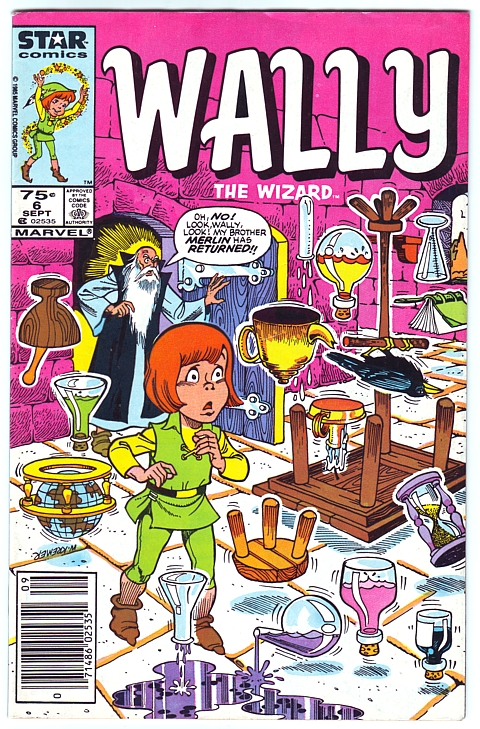 Created by ? in Wally the Wizard #1 (1985,
Marvel
Comics/Star).
Created by ? in Wally the Wizard #1 (1985,
Marvel
Comics/Star).
Key appearances:
Wally the Wizard was one of the few original creations (as opposed to licensed properties such as Thundercats) featured in Marvel's short-lived Star line of comics for young readers. Wally was the boy apprentice to the wizard Marlin -- not to be confused with his more famous brother Merlin. Marlin was actually more of a scientist, and disapproved of his brother as a charlatan and confidence man. Marlin's low opinion of Merlin was borne out when the latter showed up for a visit in issue #6.
In the interest of comprehensiveness, the following Arthurian-related characters may also be noted:
One of the main characters in Satan's Six (a 4-issue miniseries created by The Demon's Jack Kirby, 1993, Topps Comics) is Brian Bluedragon, a knight who offered service to King Arthur but was rebuffed, following which he sold his soul to Satan. Because he is neither truly good or truly evil, Bluedragon has been trapped in limbo for centuries prior to being sent back to earth with a group of similarly-ambivalent protagonists.
In an issue of Flaming Carrot Comics, a superhero parody series, artist/writer Bob Burden introduces The Shoveler, "a former ditchdigger and quarryman who found the lost shovel of King Arthur." (The Shoveler also appears in the 1999 motion picture based on Burden's work, Mystery Men, though without the Arthurian reference.)
In the miniseries Judgment Day (1997, Awesome Entertainment), writer Alan Moore creates a fictional history for the Awesome comics "universe" which includes heroes of different historical eras and comics genres (Western, sword-and-sorcery, jungle adventure, etc.). Among these heroes is The Winter Knight, a pastiche of such characters as the Shining Knight and the first Black Knight. The Winter Knight is Merlin's champion and bears a magic sword which can freeze a waterfall.
JLA Annual #4 (August, 2000, DC) introduces The Janissary, a modern-day Turkish superheroine whose origin involves her discovery of the lost scimitar of the Ottoman sultan Suleiman the Lawgiver, which was enchanted by Merlin in 1566 and hidden away by him, along with his Eternity Book, to provide a future weapon against his half-brother Etrigan the Demon. The Janissary derives her power from the scimitar (which she pulls from the sand) and from the Eternity Book.
Last updated 11/24/16. Email your comments and suggestions to Alan Stewart.